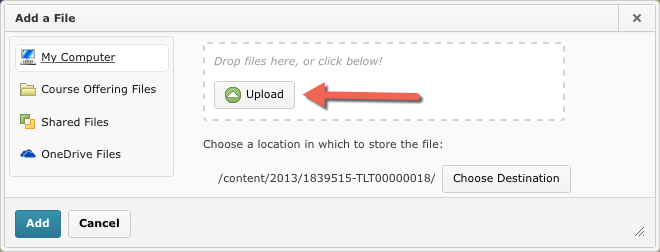Adding a new Brightspace topic by uploading a file
About this article
This article includes instructions for creating a new topic in a D2L course table of contents (TOC) by uploading a file. It has been updated to cover D2L Version 10.3 and is intended for instructors.
Upload a file using drag-and-drop
First, open up a D2L course, select the Materials menu, and select Content. Second, size your browser window such that you can get to the files you want to upload and your D2L table of contents at the same time. You can now drag files from your computer and drop them on your D2L table of contents in one of several locations depending on where you want the links to the files to appear. You can drag and drop more than one file at a time. Watch the video for more information.
- Open up a D2L course, select the Materials menu, and select Content.
- Select the module or sub-module into which you want to add a link to your file.
- Select the New button and select Upload Files from the menu (Figure 1). This opens the Add a File window.
- Select the Upload button (Figure 2)
- Browse your computer or your OneDrive for Business cloud storage for the file. Select the file and select Open. Note that you can select more than one file at a time. You will then return to the Add a File window and you will see your files queued up to be copied into the course (Figure 3).
- If you have created folders to better organize your course files using the Manage Files Tool, you can save your file to one of those folders by selecting the Choose Destination button. This opens the Select a Path window and allows you to pick a folder into which the file will be saved. If you don't use folders, you can skip this step and use the default destination.
- Select the Add button. This will return you to the table of contents where you will see a link to your file in the selected module or sub-module.
File restrictions
Special characters in the file name
Although this problem has improved over time, don't use ASCII special characters (e.g., #, @, &) in your file names. They can cause a number of problems, including failure to load the file into the viewer when you and your students select the link to it.
File type
D2L allows for the upload of most common file types, including:
- Microsoft Word, PowerPoint, and Excel
- Adobe PDF
- Common image types, such as JPG, GIF, PNG
- Common audio types, such as MP3
- Common video types, such as MOV, AVI, WMV, MP4
D2L does not allow the upload of the following file types:
- Microsoft Access ACCDB files
- Any executable file, such as EXE
File size
Currently, there is no maximum file size limit applied to D2L file uploads. In theory, you could upload an extremely large file, such as a lengthy audio or video file or an uncompressed image. In practice, you and your students will run into trouble when trying to upload and download large files (e.g., > 50 MB).
- The upload process may timeout before the file is fully uploaded to D2L.
- The D2L server cannot stream audio or video files. This means that students will need to download certain types of media files before they will start playing. Large files may take an extremely long time to download, depending on students' connection speed.
Additional details
- What happens when students download a file that you have uploaded to D2L varies based on the Web browser they are using and the type of file they are downloading.
- In order to add a topic, you must have at least one module. Every topic needs to be a child of a parent module.
- Once uploaded, your Word, PowerPoint, and other files cannot be edited in place. If you want to make changes to your syllabus.docx file, for example, you need to make those changes to the copy of your syllabus stored locally (e.g., on your computer hard drive or network drive) and then re-upload the file to D2L.
- When you upload a file, the default storage destination is the root directory. You can change that (e.g., to save the file to a folder that you created) by selecting the Choose Destination button.
- Note that when you successfully choose a file, the default No file chosen text next to the Choose File button will change to the name of the file. That does not mean that the file has been uploaded. You still need to select the Add button.
Pro tips
- If you need to re-upload an updated file (e.g., your syllabus), don't delete and recreate the topic in the TOC. Instead, upload the new file using the same file name. As long as the file names are the same, you will be prompted to overwrite the existing file. Do that and the new file will now be available through the existing topic link in the TOC.


